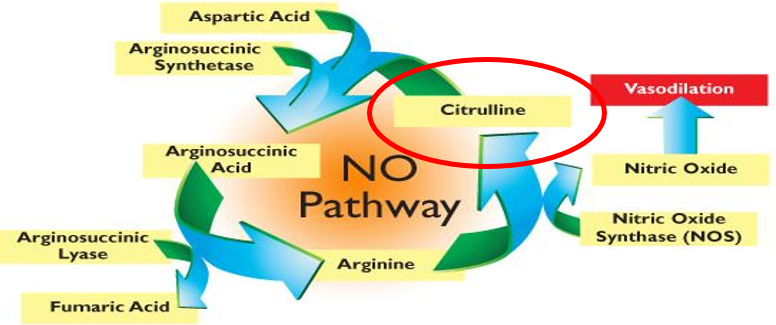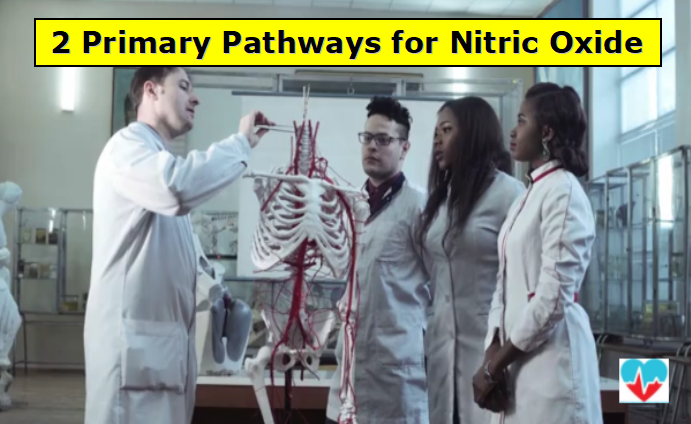In your cardiovascular system there are two primary pathways for the creation of nitric oxide. They are:
- The Nitrate Nitrite Pathway
- The Endothelial Pathway
Today we’ll examine each so that you can better understand how to harness the benefits of nitric oxide for improved cardiovascular health.
(If you would prefer to view this information in a video format, then please click on my YouTube video below:)
Both of these pathways are valid for the creation of nitric oxide. Nitric oxide is a signaling molecule. It’s used by your vascular system to improve blood flow. This molecule has three primary benefits:
First is vasodilation, which relaxes the smooth muscles of the blood vessels so that they expand. This improves the deliver of oxygen and nutrients. As well as aids in the removal of cellular waste. And, it can be a natural way to lower blood pressure back into the normal range.
Additionally, men cannot have an erection without nitric oxide so sexual health is also dependent on your nitric oxide levels.
Second, nitric oxide keeps blood platelet cells from sticking together, which naturally reduces your risk for strokes and heart attacks.
Third, nitric oxide helps to initiate repair mechanisms to keep the lining of your vascular system, what is call the endothelium, healthy and functioning.
Now, let me give you an overview of each pathway. Then at the end, I’ll give you my opinion on which pathway can benefit you the most.
Let’s start with the Nitrate Nitrite Pathway.
In your mouth are enzymes that convert nitrates to nitrites, which can then be converted to nitric oxide in your bloodstream.
This pathway is dependent upon several key items.
First, you must consume foods that contain nitrates. Green leafy vegetables and root plants such as beet root are your best sources.
Second, the enzymes that convert nitrate to nitrite are from bacteria in your saliva. Without these bacteria you cannot access this pathway for the creation of nitric oxide.
Most mouthwashes kill this bacteria. This means that if you use a daily mouthwash, then you severely limit your production of nitric oxide.
Third, your stomach acids are also important in the chain of events needed to convert nitrites to nitric oxide.
As we age our stomach acids decrease. Or if you use antacids to neutralize your stomach acidity, then you decrease your ability to create nitric oxide through the Nitrate Nitrite Pathway.
This is also a short lived pathway.
Meaning once the nitrate has been converted to nitrite, the nitrites are then used up in the creation of nitric oxide.
And while there are other metabolic pathways that can produce nitric oxide, from reformed nitrites, they require special conditions to be effective.
Because of all this, the Nitrate Nitrite Pathway has limitations on long term therapeutic increases in nitric oxide.
Supplements that use beet root as their primary source will typically include the amino acid L-citrulline to help extend their product’s production of nitric oxide.
L-citrulline does not use the Nitrate Nitrite pathway.
Instead, it uses the Endothelial Pathway for the creation of nitric oxide.
The endothelium in a one-celled lining of your entire vascular system. This tissue regulates most of your cardiovascular health.
Contained in this endothelium are enzymes called eNOS, which converts the amino acid L-arginine into nitric oxide.
Here is an image to help you understand this metabolic process.

A couple of items to note:
First, it is L-arginine that is converted to nitric oxide. And if all you supply these eNOS enzymes with is L-arginine, then it is a short lived pathway for the creation of nitric oxide.
This is where L-citrulline comes in. This amino acid will be converted by your liver into L-arginine to help fuel the eNOS enzymes in their production of nitric oxide.
Additionally, as you can see by the image, L-citrulline also reforms L-arginine after the nitric oxide has been produced. This action significantly extends your ability to produce nitric oxide over a much longer period of time.
Second, calcium is need for the proper function of the eNOS enzymes. Without calcium you would be limited in your production of nitric oxide through the Endothelial Pathway.
Ingredients like vitamin D3 and vitamin K2 help to regulate these calcium levels. This improves the function of the eNOS enzymes for higher production of nitric oxide.
Third, there are other nutrients that can also boost the production of nitric oxide via the Endothelial Pathway. Key ingredients like:
- Pomegranate Fruit Concentrate
- Red Grape Polyphenol Extract
- Vitamin C
- Vitamin B6
- Vitamin B12
can also help improve the creation of nitric oxide.
Because of this I believe the best way to improve nitric oxide levels in your body is to properly harness the power of the Endothelial Pathway.
This pathway has the greatest surface volume for the creation of nitric oxide.
Plus, there are multiple ways to improve the function of this pathway for the creation of nitric oxide.
In my video The Truth About L-Arginine I go into extensive detail on this subject.
And if you want to go into greater depth and detail, I have additional links to help you better understand both of these pathways for the creation of nitric oxide.
https://www.ahajournals.org/doi/10.1161/CIRCULATIONAHA.114.014149#:~:text=A%2C%20The%20nitrate%E2%80%93nitrite%E2%80%93,reactions%20that%20ultimately%20facilitate%20vasodilation.&text=The%20mechanism%20by%20which%20nitrite%20dilates%20conduit%20arteries%20is%20still%20unknown Harnessing the Nitrate–Nitrite–Nitric Oxide Pathway for Therapy of Heart Failure With Preserved Ejection Fraction
https://www.nature.com/articles/nrd2466 The nitrate–nitrite–nitric oxide pathway in physiology and therapeutics
https://www.ncbi.nlm.nih.gov/pmc/articles/PMC2517837/ Endothelial nitric oxide in humans in health and disease
https://www.sciencedirect.com/topics/medicine-and-dentistry/endothelial-nitric-oxide-synthase Endothelial Nitric Oxide Synthase
Blessing Lives Through Nitric Oxide Therapy!
Dan Hammer

Leave a Reply
You must be logged in to post a comment.